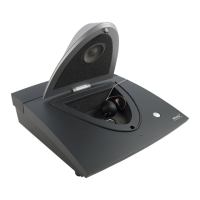Affinity
2.0
Additional Information Page 135
For people with low-frequency dead regions, as can occur, for example, in cases of Ménière’s syndrome,
there appears to be some benefit of amplifying frequencies above 0.57fe, but not of amplifying frequencies
below 0.57fe.
20,21
Amplification of frequencies below 0.57fe can actually lead to reduced speech intelligibility.
In rare cases, the audiogram may have the form of an inverted V; hearing is relatively good over a small
frequency range, and poor at all remaining frequencies. This can indicate a restricted functioning region in
the cochlea, with extensive dead regions below and above it.
22-24
However, it is not safe to make a diagnosis
of dead regions based solely on an inverted V-shaped audiogram
23
; a test such as the TEN(HL) test is
needed for a firm diagnosis. For a patient who does have a restricted functioning region, with dead regions
above and below the functioning region, the most effective amplification strategy may be to amplify over a
limited frequency range around the functioning region.
24
The TEN(HL) test may also be relevant for patients who are being considered for a cochlear implant; a
patient with very extensive dead regions would be likely to do better with a cochlear implant than with a
hearing aid (or aids). The test may also be useful for patients who are being considered for a combination of
a cochlear implant and a hearing aid. Such patients typically have a dead region in the parts of the cochlea
that normally respond to medium and high frequencies, but have some functional hearing at lower
frequencies. It may be useful to determine the edge frequency, fe, of any dead region. This may be relevant
to choosing the most appropriate insertion depth of the electrode array, and to the way that frequencies in
the input signal are mapped to acoustic and electric stimulation.
25
The clinician needs to be alert for some special cases. Patients with auditory neuropathy sometimes have
high thresholds for detecting the test tone in the TEN, meeting the TEN(HL) test criteria for diagnosis of a
dead region, even for frequencies where their audiometric thresholds are near normal.
26
This does not
necessarily indicate that they have extensive dead regions, although they may have only patchy survival of
IHCs.
27
Patients may also have high thresholds for detecting the test tone in the TEN as a result of central
problems, for example brain injury in auditory areas resulting from trauma or a stroke.
28
These high
thresholds may result from poor “detection efficiency” rather than from dead regions. Nevertheless, high
thresholds in the TEN are likely in all cases to be associated with a poor ability to understand speech when
background sounds are present.

